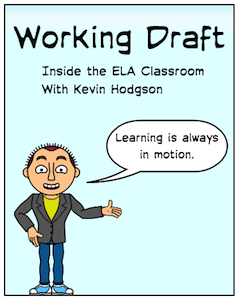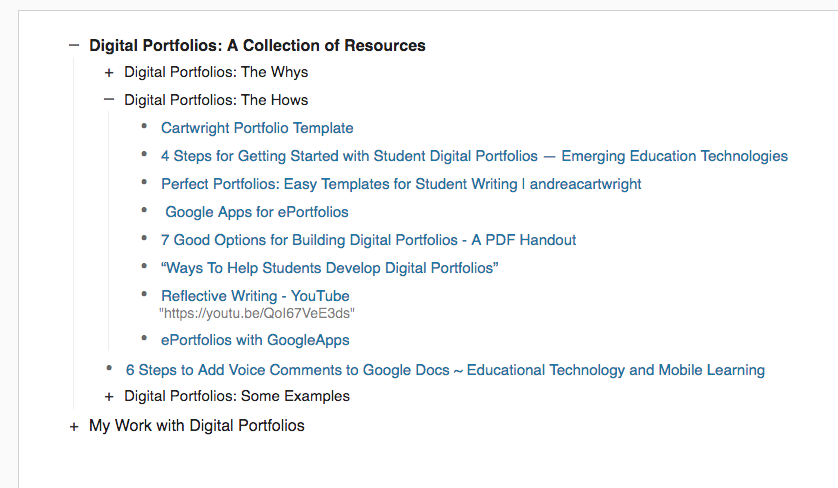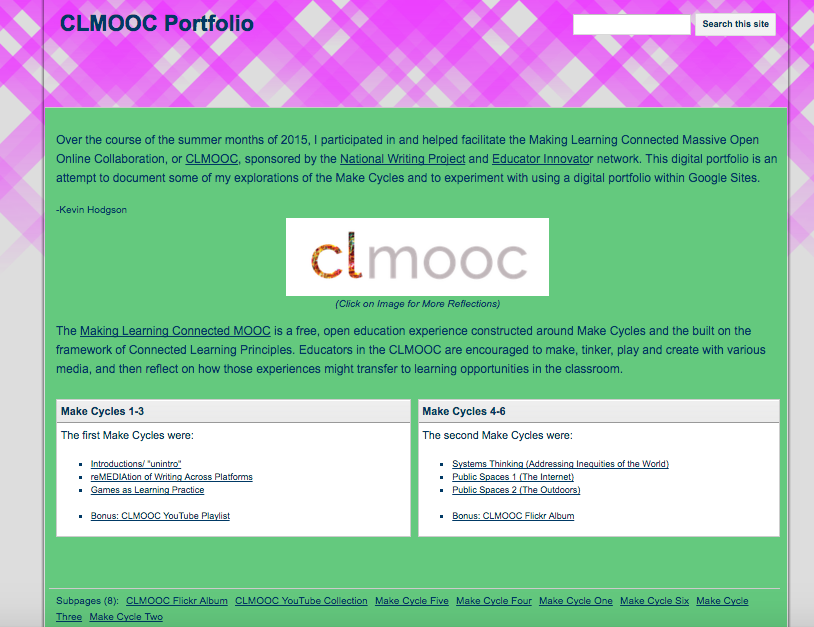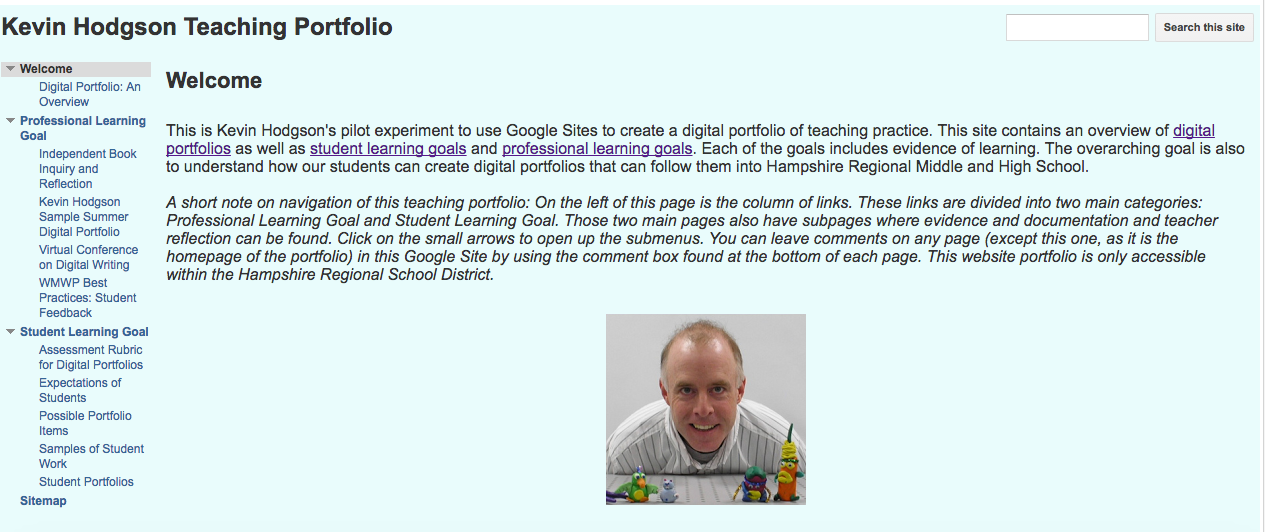Exploring the Potential of Digital Portfolios
A MiddleWeb Blog

This “progress” monitoring involves collecting and collating lots of artifacts. Every other year, during our summative evaluation cycle, we have to turn in a binder of materials that shows how our work has aligned to four main strands of our state’s expectations of teachers.
This year, I am moving away from the overstuffed three-ring binders and into the realm of a digital content management. Both my professional learning goal and my student learning goals center on developing and piloting a system of digital writing portfolios for myself and for my sixth graders.
I have done quite a bit of exploration this year, trying to gather a rationale for moving into digital archiving of work and finding ways to make this happen in as manageable a process as possible.
Student portfolios with shelf life
As I write this post, my students have been writing and reflecting all year in their Google Apps for Education accounts. They have nearly 25 pieces of writing to consider, and we still have poetry and argumentative writing to get to before the school year ends in mid-June.
From this array of writing, they will be choosing five pieces from which to build a digital portfolio website, complete with reflections. This will be shared not just with me, but also with family and (this is where I am most intrigued) with teachers in the middle school and high school in years to come.

For now, I want to share my own process of researching the ins and outs of digital portfolios, how I’m developing one for myself as teacher, and what I’m learning about both the potential and the pitfalls of using Google Sites as the platform for collecting digital work.
The genesis of my search
Many years ago, I did another pilot program with digital portfolios. Sort of. This was before our school had wireless access to the Internet. With only a handful of desktop computers, we tinkered with using Powerpoint as a place for students to share writing. One slide would feature writing. The next slide would be reflection. We burned the slideshows on CD discs, and sent them home.
Even then, I had a glimpse of the potential power of students’ gathering some of their writing, reflecting on what they had done, and tracking their own progress over time. Not just in the months that I was their teacher. But beyond their time with me, too.
That pilot didn’t go very far, but it did plant a seed. Powerpoint wasn’t a very effective tool for what I was trying to do. This was before the era of ubiquitous flash drives, and “cloud computing” was an unknown technology term. Moving files off the computers was difficult and not very effective. Plus, more than half of our families did not have regular access to computers.
Digital progress
Times have changed, of course, and now many of the high hurdles from those days are long gone. It’s a perfect time to leap back in. In particular, our school district’s push into Google Apps for Education makes the transition to digital portfolios easier – and using Google Apps to build out a reflective site for writing makes the most sense, for now anyway.
That said, Google Sites, the website builder in Google Apps, is rather clunky to use. Luckily, I came across a template that I adapted for our use that I think will work.
I have spent much of the year doing my research on digital portfolios. You can find many of the links and resources that I have found useful, including some reflective blog posts, at this Diigo Bookmarking Outliner I set up for myself.
As always, I knew I had to try to build my own digital portfolio as an experiment. So I looked back to my time last summer with the Making Learning Connected MOOC, and used the idea of a digital portfolio as a way to document my own learning through the six Make Cycles of the CLMOOC. The result? Fair, I’d say, but not great. But it provided me with a first step forward. Go to my CLMOOC Digital Portfolio.
Creating a digital professional portfolio
This spring I began building my professional portfolio, with the blessing of my principal. I have been collecting screenshots and evidence and artifacts into a folder, all year long, and I’m grateful I was organized early on. My archive made the construction of the portfolio, using a template via Google Sites, easier.
I am pretty satisfied with how this teaching portfolio came out, and there is room for my principal to leave comments in each section. I won’t make this portfolio public, due to the student work examples it contains, but you can get a glimpse of it here.
In the coming weeks, I will be guiding my students into Google Sites, using the portfolio template as a means and my own portfolio as a model. They will be collating some of their favorite pieces of writing this year, from poems to interactive fiction to audio stories to comics to essays and more. In a follow-up post in June, I’ll let you know how it goes for me. See you then.


































Kevin, I’m wondering if one of the most valuable aspects of documenting your teaching this way is determining what goes into your digital portfolio and what does not?
Something that you post made me think about: The supervisor during my first year of full time teaching told me that one of the most significant differences between being in school and being a professional is that as a professional the end of the school year does not truly mark the end of something, as it does as a student. Professionals know that they need to keep reflecting on their practice and improving it. Your portfolio will enable you to do just that.
Thanks for sharing!
Andrew Pass
http://www.apasseducation.com
Hi Andrew
There is no doubt that curation is a key component here, and it will be interesting to teach that to my students. How we do go about choosing a representative body of work over time? Do we just find the “good stuff” or do we find the “not so good stuff” too as a way to reflect more on what we could have done different?
Kevin
I really like your ideas here – and hope to head in this direction at my school. I think the role of active curation is key here – not all of the items one might keep will stand out as such in the moment. I find myself about how to save most or all of what we do – lots of cell phone pics (which also need to be put in a useful place) or visits to the scanner? Hard to say but I’m eager to make it happen.
What’s interesting, though, is how a teacher portfolio really should show all the good/best stuff (you’re being evaluated, at least in my state) while a student portfolio should feature a mix of good and so-so work, with reflections on what makes the good/good and how could you make the so-so/better. So, there is a divide between what portfolios mean for us, as educators, and for our students, as writers and learners. I just realized that, after reading your comment, Heather.
Sincerely,
Kevin
Kevin, I find it sad, though real, that teachers are evaluated through portfolios. Is there room in the evaluation to say that a teacher might not have been excellent in this skills when he/she first used it in class but because the teacher had the courage to experiment with something new, over time, he/she was able to develop deep expertise with the skill?
Andrew Pass
http://www.apasseducation.com
Well, to be fair, we are not evaluated solely on portfolios. There are class visitations by administrators and other elements. I’m not defending the system, just acknowledging that various elements. And, there is room to say “I didn’t meet my goals and here is why …” in the portfolio reflection, too.
OneNote can also be used for portfolios: https://blogs.office.com/2016/04/20/onenote-class-notebook-as-an-e-portfolio/ I did something similar to you for my evaluation cycle / SMART goals. This being the first year of a 2 year cycle – the printed OneNote Notebook is over 340 pages
Although OneNote is old, OneNote Class Notebook is new and is arguably, imho, better already than Google Docs. I would urge those experienced with Google Docs, and those not, to compare: https://www.onenote.com/classnotebook (Though OneNote is free to all teachers, it should be noted that I work in an Outlook school – so we – students and teachers – have the full suite of Microsoft tools. And this makes working with OneNote a bit easier.)
Perhaps this could be a future Middleweb article.
Jeremy
OneNote looks like another possible system. Do the accounts follow kids through the years ahead? There are many quirks and constraints with Google Apps for portfolios … definitely … so exploring different options always makes sense for an individual teacher.
Thanks for stopping by …
Kevin
They certainly would in an Outlook school.
If you were a teacher self adopting, kids could easily copy the work they had done onto their own OneNote – but I believe this could be easily done in Google if kids wished to do so…